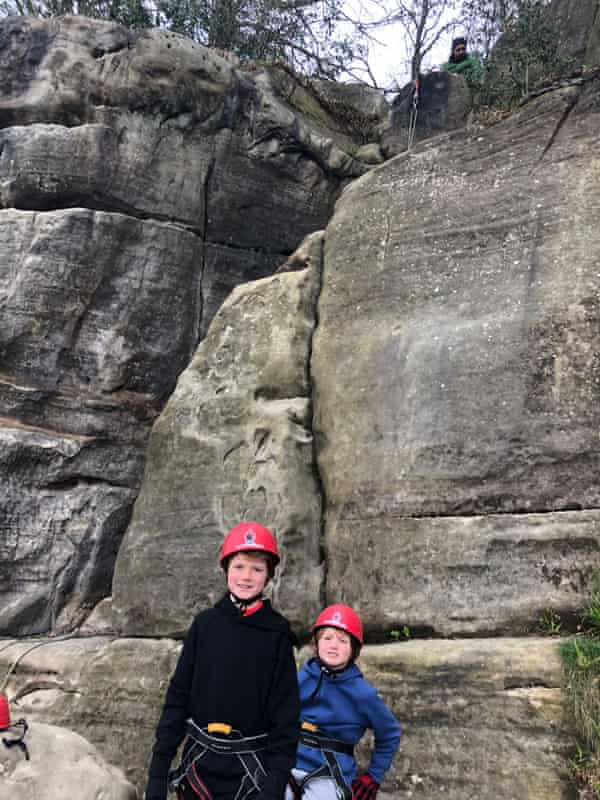“I have no idea where to put my foot,” says my 10-year-old son, his voice a mix of fret and frustration. He is stuck halfway up a six-metre rock face, looking down at us for assistance.
I’m standing at the bottom holding his rope with our guide, Chris McCellan from Hatt Adventures, and my eight-year-old, who is groaning loudly about the wait and pulsing with impatience for his turn. “I can’t tell you what to do,” says Chris kindly to the older one. “It’s like a puzzle, you have to try a few things out.”
We’ve come to Harrison’s Rocks in East Sussex, a crag of Southern Sandstone in pretty woodland just outside of Tunbridge Wells, to have a go at rock climbing. The boys have been to indoor walls a few times, and always enjoyed it, but it’s quickly becoming clear that climbing outdoors, away from the neon colour-coded routes and knobbly plastic handholds, is a very different beast. The holds are not obvious, and the rock feels rough and unforgiving.

Indoor climbing has grown exponentially in the UK over the last decade. There are now more than 400 walls and, before the pandemic, almost a million people climbed indoors every year according to the Association of British Climbing Walls. This summer, climbing will make its Olympic debut in Tokyo, which is sure to increase demand further.
But while Chris welcomes the interest and increased participation in the sport he’s been passionate about his whole life, he’s not sure that the simulated indoor setup always gives people, especially kids, the best grounding for real rock climbing.
“To be as accessible as possible, some walls are as easy to climb as a ladder, so the kids can race up them,” he says. “Whereas outdoors you have to take your time and work things out, and sometimes sit with that difficulty.”
As my son is having to do now. An alien concept given so much of kids’ lives today, from learning times tables online to messaging friends or playing Fifa, involves getting quick endorphin hits and doing things at a hundred miles an hour. It’s nice to watch him slow down. And he does work it out eventually, beaming down at us from the top while he’s unclipping himself. Delayed gratification in action.
The younger one has the advantage of following his brother’s route, and I manage to not embarrass myself and get up to the top too. While Chris sets up our next climb, he tells us Harrison’s Rocks is owned by the British Mountaineering Council, and there are over 400 routes of varying difficulty on the crag, including the beginner routes we’re doing today. The sandstone is too fragile for lead climbing, where the climber in front is roped to those who follow, so climbers use top roping, where the rope runs through a bolt at the top of the route, instead.
Before this trip, I’d had no idea there was such good rock climbing within an hour of London. It’s certainly popular on the bright but cold Sunday morning we’re here. After a short walk through Birchden Wood (we parked in the Forestry Commission-managed car park, though you can also get the train to nearby Eridge station and walk 1.8 miles) the rocky outcrops rise up through the forest out of nowhere. We see groups of young friends crowding around boulders with crash mats and their hands held up in the catch position, couples with dogs and sometimes toddlers in tow, and a lot of Patagonia fleeces.
We do a few different routes throughout the morning and Chris is generous with the general tips (eg, “push up with your legs, don’t just use your arms”); but when it comes to decision-making he encourages us to experiment, frequently reminding us that we’re securely attached to his rope, so we don’t need to worry about falling.
Taking turns means we rest a lot more than we would at the local bouldering wall, where you can climb almost constantly for two hours, but we all feel more tired somehow, perhaps just from the sensory overload and excitement of climbing outside.
For my part, I really enjoyed the physicality and accomplishment of completing each route, the feel of weathered rock on my fingertips, and watching the kids grow in confidence as the day wore on. But I also liked being in a tranquil forest with no traffic noise, and air clean enough for lichen to grow everywhere.
This year more than ever, it’s feels important to find fun, active stuff we can do as a family out in nature. If that also involves a lesson in the power of patience and perseverance, so much the better.




